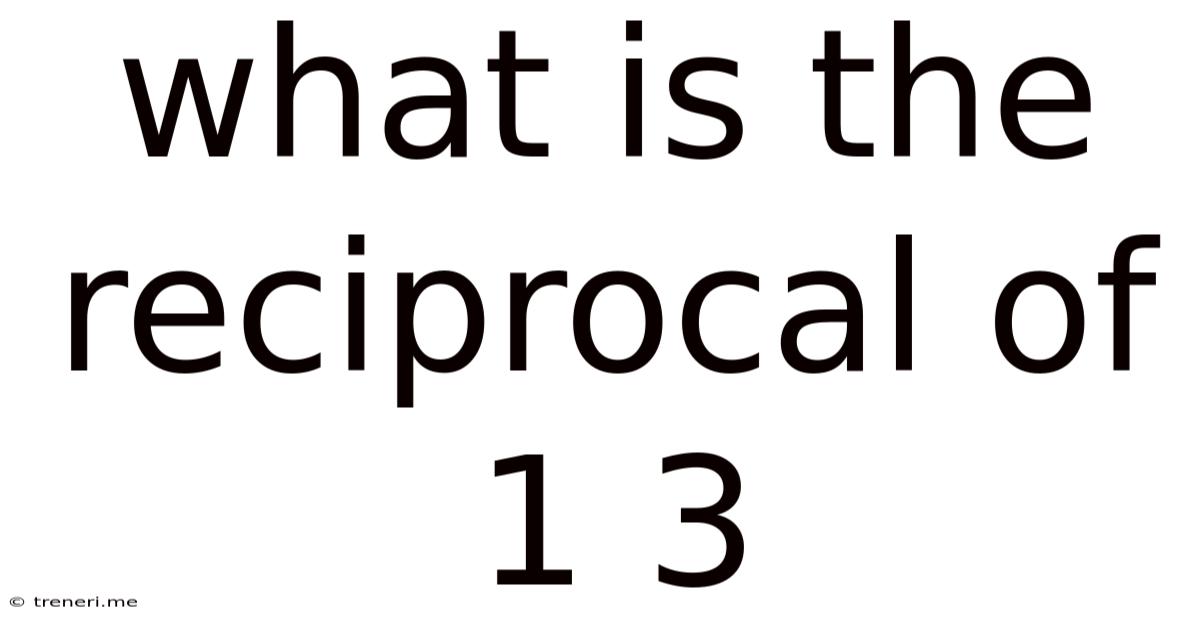What Is The Reciprocal Of 1 3
Treneri
May 11, 2025 · 4 min read

Table of Contents
What is the Reciprocal of 1/3? A Deep Dive into Mathematical Reciprocals
The question, "What is the reciprocal of 1/3?" might seem deceptively simple at first glance. However, understanding reciprocals goes beyond simple arithmetic; it unlocks a deeper understanding of fundamental mathematical concepts and their applications in various fields. This comprehensive guide will not only answer the initial question but delve into the broader concept of reciprocals, exploring their properties, applications, and importance in mathematics and beyond.
Understanding Reciprocals: The Multiplicative Inverse
The reciprocal of a number is its multiplicative inverse. In simpler terms, it's the number that, when multiplied by the original number, results in 1 (the multiplicative identity). This concept is crucial because it allows us to solve equations, simplify expressions, and understand more complex mathematical structures.
Finding the reciprocal is straightforward for most numbers:
- For integers: The reciprocal of an integer 'a' is simply 1/a. For example, the reciprocal of 5 is 1/5.
- For fractions: The reciprocal of a fraction a/b is b/a, provided that 'a' is not zero (division by zero is undefined). This is because (a/b) * (b/a) = 1.
The Reciprocal of 1/3
Now, let's address the specific question: What is the reciprocal of 1/3?
Using the rule for fractions, we simply invert the numerator and the denominator:
The reciprocal of 1/3 is 3/1, which simplifies to 3.
This means that (1/3) * 3 = 1. The product of a number and its reciprocal always equals 1, verifying our answer.
Exploring Reciprocals in Different Number Systems
The concept of reciprocals extends beyond simple fractions and integers. Let's explore how it applies to other number systems:
Reciprocals of Decimals
To find the reciprocal of a decimal, first convert it to a fraction. Then, invert the fraction to find the reciprocal.
For example:
- The reciprocal of 0.5 (which is 1/2) is 2/1 = 2.
- The reciprocal of 0.25 (which is 1/4) is 4/1 = 4.
- The reciprocal of 0.75 (which is 3/4) is 4/3.
Reciprocals of Negative Numbers
The reciprocal of a negative number is also negative. This is because the product of two negative numbers is positive, ensuring the result of multiplying a number and its reciprocal remains 1.
For example:
- The reciprocal of -2 is -1/2.
- The reciprocal of -1/5 is -5.
Reciprocals and Zero
The number 0 has no reciprocal. This is because there is no number that, when multiplied by 0, equals 1. Division by zero is undefined in mathematics. This is a fundamental concept to remember.
Applications of Reciprocals
Reciprocals are not just theoretical concepts; they have practical applications in various fields:
Algebra and Equation Solving
Reciprocals are essential in solving algebraic equations. For instance, when dealing with equations involving fractions, multiplying both sides by the reciprocal of a fraction can eliminate the denominator, simplifying the equation.
Consider the equation: (1/3)x = 5. To solve for x, we multiply both sides by the reciprocal of 1/3, which is 3:
3 * (1/3)x = 5 * 3
x = 15
Physics and Engineering
Reciprocals frequently appear in physics and engineering formulas. For instance, in optics, the reciprocal of the focal length of a lens is related to its power. In electrical circuits, the reciprocal of resistance is conductance. Many other physical relationships are expressed using reciprocals.
Computer Science and Programming
Reciprocals are used in various algorithms and programming tasks. For example, in calculating probabilities, finding the inverse of a probability value (its reciprocal) is common.
Finance and Economics
In finance, reciprocals are used in calculations related to interest rates, discounting, and present values. For instance, the reciprocal of an interest rate can be used in calculating compound interest.
Advanced Concepts Related to Reciprocals
The concept of reciprocals opens doors to more complex mathematical ideas:
Inverse Functions
The idea of a reciprocal is closely related to the concept of an inverse function. A function and its inverse function "undo" each other. For example, the function f(x) = 3x has an inverse function f⁻¹(x) = x/3. While not precisely the same as a reciprocal, the relationship is closely linked.
Matrix Inverses
In linear algebra, matrices have inverses. The inverse of a matrix A, denoted as A⁻¹, is a matrix such that A * A⁻¹ = I, where I is the identity matrix. Finding matrix inverses is crucial in solving systems of linear equations and various other linear algebra problems.
Conclusion: The Significance of Reciprocals
The seemingly simple concept of the reciprocal—the multiplicative inverse—holds significant mathematical weight. It's a cornerstone of numerous mathematical operations and concepts. From solving basic algebraic equations to advanced linear algebra and applications in diverse fields like physics and computer science, understanding reciprocals is essential for anyone pursuing a deeper understanding of mathematics and its applications in the real world. The reciprocal of 1/3, being 3, serves as a simple but vital illustration of this fundamental concept. Grasping the concept of reciprocals not only helps in solving specific problems but also enhances mathematical intuition and problem-solving skills.
Latest Posts
Latest Posts
-
40 Out Of 50 Letter Grade
May 11, 2025
-
1 5 3 4 As A Fraction
May 11, 2025
-
16 By 16 Is How Many Square Feet
May 11, 2025
-
How To Find Ucl And Lcl
May 11, 2025
-
How Many Miles Is 35 000 Feet
May 11, 2025
Related Post
Thank you for visiting our website which covers about What Is The Reciprocal Of 1 3 . We hope the information provided has been useful to you. Feel free to contact us if you have any questions or need further assistance. See you next time and don't miss to bookmark.